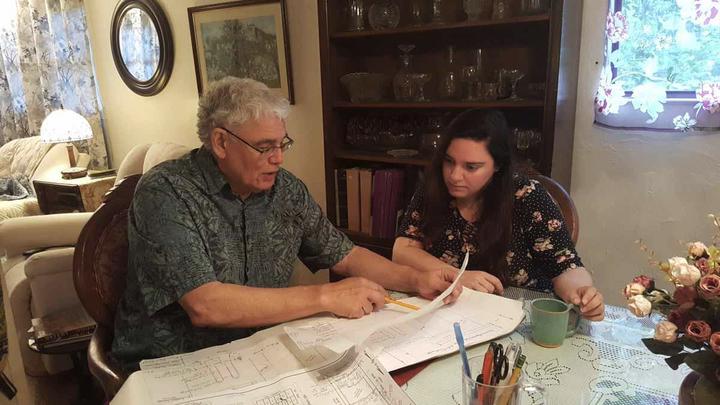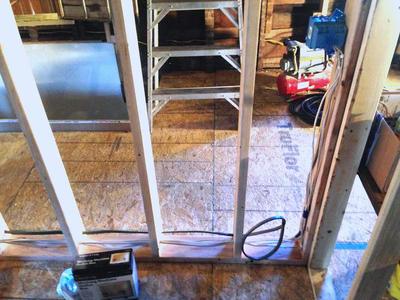Martin Likes Math Too
An Interview With a Contractor
 Copyright 2020 Crystal Construction Consulting, Inc.
Copyright 2020 Crystal Construction Consulting, Inc.Martin Espinosa is a contractor who repairs houses and commercial properties and provides construction consulting. He recently launched his consulting website at crystalconstructionconsulting.com.
He’s also my dad! In this interview, I ask him about how he uses math in his construction business.
River: So, tell me a bit about what you do.
Martin: I’m a General Contractor in California. Right now I mostly do repairs of all kinds to residential work and light commercial work. Those repairs can involve electrical or plumbing or sheetrock or windows or doors or dryrot.
River: And what does that mean, to be a General Contractor?
Martin: It means I can build almost anything in residential or light commercial construction. I can’t do engineering projects like roads or bridges or something like that. But pretty much anything that can be built I build as a general contractor.
River: Do you use math in your repair work?
Martin: I use math literally every day, almost every hour that I work! I’m always measuring things. For example, if I have to build a wall 5 feet tall, I have to calculate a bunch of numbers to figure out what the height of my vertical studs would be. The studs are on top of a piece of wood, and they have a piece of wood on top of them. So the studs would be a little shorter than 5 feet tall.

It sounds real simple, but if you make a mistake, then the wall will be the wrong height.
River: So what happens if the wall is the wrong height?
Martin: Then I have to redo the wall, at my cost. I don’t want to be making that kind of mistake.
River: It would cost you money.
Martin: That’s right!
River: Are there any other ways that you use math while doing repairs?
Martin: As a matter of fact, the shed that I’m building right now, I had to square it up to make sure it’s exactly 12 feet by 12 feet. I ran string lines going in both directions and I used the Pythagorean Theorem (a² + b² = c² ).
I’ve been using that ever since I started being a contractor, and I’ve taught it to almost every carpenter who’s ever worked for me. You can take the right triangle in the corner of a room or a building and you can make it square by going 3 feet, 4 feet, 5 feet. All of my carpenters in California and all of my carpenters in Florida know how to square up a corner of a building by using that simple equation. Even though they don’t remember the equation, they remember 3, 4, 5.
River: 3, 4, 5 triangles!
Martin: 3, 4, 5 triangles. In this case, I had two string lines and I used my tape measure with another carpenter. I was able to move my string lines to the left or the right in order to make that corner square.
Then I did it to the other three corners, and when I was finished, all four corners were square. Underneath that, I put in my foundation blocks and all those were right smack under the lines that I had used for making my room square.
When you have a really big space, if you measure the diagonals, they have to be exactly the same length.
River: They do! They do!
Martin: And so I did that last week. After I did my 3, 4, 5 triangles I measured the diagonals and I was right on the money, not even a 16th of an inch off. That was satisying to know that geometry gave me a perfect square.
River: So, do you like math?
Oh, yeah! I’ve always been good with numbers. When someone tells me something costs x amount of dollars I can say “oh, that’s so much per month or so much per day or so much per week”. I like to be able to do that.
River: Did you like math when you were in school?
Martin: Yeah. I really liked it in grammar school where it was mostly addition and subtraction and multiplication and divison. When I got into high school and college I did algebra and geometry. I loved geometry because it showed me how the world is put together, in angles, circles, squares, rectangles, parallelograms, everything! All of those things I have to do all the time in my work.
There was a job in which I had to install a window that was an oval, so I knew I need two centers of focus and I had to take my string line and put a pencil on that string line and go around both of them at the same time. Then I took that and cut it out and gave it to the window contractor and the window contractor made it from my template. So that was fun!
 is licensed under [CC BY SA 3.0](https://creativecommons.org/licenses/by-sa/3.0/)](/post/interview-with-a-contractor/Drawing_an_ellipse_via_two_tacks_a_loop_and_a_pen_hu75b7b8b9f5f5b266d7468c87fd42e934_153713_d4faff1b86d17fdffd1fffe60b02ff65.jpg)
River: Why do you think you like math?
Don’t have a clue. It’s just part of my makeup. Just like River Likes Math, you might say Martin Likes Math too.
Part 2 of the interview will be up soon! We’ll talk about how Martin uses math in his consulting business, why he thinks that some people hate math, and the relationship between math and music.